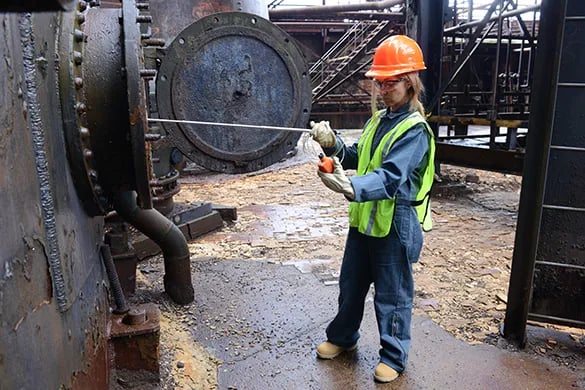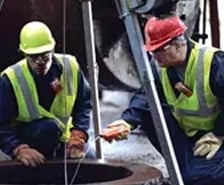
Confined Space
Confined spaces can be extremely dangerous—low oxygen levels, combustible gases, and toxic substances are just a few of the threats a worker may encounter. Confined space monitors can detect these hazards and more.
Confined spaces are found in a range of industries and their hazards vary from location to location. Before entering a confined space, you need to understand the regulations, obtain permits, gear up, and test the atmosphere and gases in the space with a confined space monitor. These potential hazardous gases include:
Continuous monitoring is simple with an area monitor like the Radius® BZ1, allowing you to eliminate the need to re-test the confined space and catch changes in environmental conditions before evacuation is necessary.


The nature of confined spaces makes communication challenging. You should equip entrants with a connected, personal confined space monitor like the Ventis® Pro5 that automatically shares alarms and gas readings from within the confined space with peers and an attendant. This connectivity lets the team continue their work without depending on manual check-ins that disrupt productivity at best and at worst, can cost someone their life if timed incorrectly.
Real-time text and email alerts through iNet® Now live monitoring provide clear visibility into gas hazards in confined spaces from anywhere, so rescuers can act quickly and effectively while avoiding further incidents.
Make sure you have access to the information you need to protect confined space workers and responders with a network of connected confined space gas monitors and the data they collect.


E-BOOK
The Complete Guide to Gas Detection in Confined Space
Learn the best practices for detecting gas hazards in confined spaces and how to use confined space monitors to detect invisible hazards.

INFOGRAPHIC
Three Steps To Detecting Gas Hazards In Confined Spaces
Confined spaces present unique dangers. Limited exit points coupled with a potentially hazardous atmosphere mean you need a plan for how to test, enter and exit a confined space safely.

BLOG
A Guide to Remote Sampling Basics
Confined space entries need to be handled with caution. This includes testing the atmosphere within using your confined space monitor, sampling accessories, and pump equipment.
Frequently Asked Questions
What are the primary gas hazards in confined spaces?
Low oxygen levels are the most common gas-related cause of death in confined spaces. Additionally, due to confined space work being prone to communication problems, The National Institute for Occupational Safety and Health (NIOSH) reports that 60% of confined space deaths are among these “would-be” rescuers who enter a confined space without understanding the hazards within.
These risks can be mitigated with connected devices like the Ventis® Pro5 or Radius® BZ1.
What is a safe LEL Level in confined spaces?
A safe lower explosive limit, or LEL, level in confined space depends on the gas hazards present.
Find a comprehensive list of acceptable LELs for combustible gases in our blog on understanding acceptable and dangerous gas hazards in confined spaces.
How do I improve communications in a confined space entry?
Poor communication can lead to unexpected and unwanted outcomes during a confined space entry.
The most effective way to accomplish proper communication is for each entrant in the space to carry a portable, personal multi-gas detector such as the Ventis® Pro5. Conditions can also be monitored remotely or from multiple spaces at the same time with iNet® Now Live Monitoring software.



